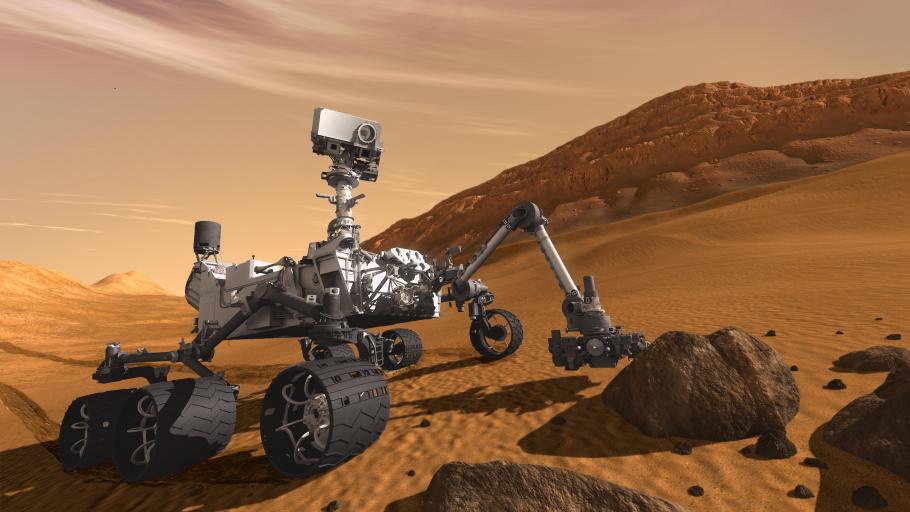Artist's concept of the Mars Science Laboratory rover Curiosity performing tasks on the surface of Mars.
The Mars Science Laboratory (MSL) Curiosity (Fig. 1) and Mars 2020 Perseverance missions are the next step in NASA's Mars Exploration Program following the Mars Exploration Rovers, Mars Reconnaissance Orbiter, and Phoenix missions. Launched in late 2011, the MSL rover arrived at Mars in early August 20121. The main objective of the MSL mission is to "assess habitability" of both Mars' past and present environments1. Launched in 2020, Mars 2020 Perseverance arrived at Mars in February 20212. Science objectives of the Mars 2020 mission include: exploration of an ancient astrobiologically relevant environment that preserves information to constrain the geological record, including past habitability and biosignature preservation potential; searching for potential biosignatures; and caching samples for possible future return to the Earth2.
The NASA-appointed Mars Landing site steering committee, co-chaired by Dr. John Grant, co-led the science community MSL landing site selection process and helped evaluate the landing site in Gale crater for Curiosity3, 4and Jezero crater for Perseverance5. In Gale crater, there is a thick mound of layered rocks (dubbed Mt Sharp) that are yielding information on the past conditions and habitability of Mars that includes the presence of a long-live lake and a record of drying conditions over time. In Jezero crater (Fig. 2), Perseverance is exploring ancient lake beds and a delta along the margin of the crater and may eventually venture westward to explore diverse rocks outside of the crater.
Curiosity and Perseverance are near identical twins and both are rich with technological advancements starting with the innovative “sky-crane” landing procedure and extending to the types of instruments loaded onto the very capable rovers. The landings involved the descent of the spacecraft by parachute and immediately prior to landing, the lowering of the rover on a tether to the surface1. Both rovers are equipped to roll over obstacles up to 75 cm high. Through scooping and drilling the surface, the MSL rover will be able to collect soil and rock samples that can be chemically analyzed in situ in test-chambers on the rover. To assess past habitability at the landing site, sample analyses will focus on identifying organic components, such as proteins and amino acids, and atmospheric gases essential for life. The Mars 2020 rover is using its instruments to search for possible biosignatures and to choose the best samples to cache for eventual return to Earth.
The processes to select the landing site for MSL and Mars 2020 built upon the process employed for selecting the landing sites for the Spirit and Opportunity rovers and was co-convened and co-chaired by Dr. Grant of CEPS and both involved a series of community workshops and exhaustive evaluation by the MSL and Mars 2020 Science Teams and Project at the Jet Propulsion Laboratory3-5. By involving the broad science community in these workshops, the process ensured identification of a landing site meeting all the specified engineering and safety requirements, as well as providing the greatest scientific value3-5. Landing site selection and evaluation activities relied heavily on data provided by the Mars Reconnaissance Orbiter (MRO) that enabled comprehensive study of the final candidate sites for both missions3,5. A broadly similar process helped to select the landing sites in Gusev crater and Meridiani Planum for the Spirit and Opportunity rovers, respectively.
1). NASA Jet propulsion Laboratory (2008). http://mars.jpl.nasa.gov/msl
2). Farley, K.A., Williford, K.H., 2017. Seeking signs of life, and more: NASA's Mars 2020 mission. Eos 98. https://doi.org/10.1029/2017EO066153.
3). Grant, J. A., et al. (2010), The science process for selecting the landing site for the 2011 Mars Science Laboratory, Planet. Space Sci., 59, 1114-1127, doi:10.1016/j.pss.2010.06.016.
4). Golombek, M. P., J. A. Grant, et al. (2012), Selection of the Mars Science Laboratory landing site, Space Science Reviews, doi:10.1007s11214-012SPAC875R1.
5). Grant, J.A., M. P. Golombek, S. A. Wilson, K. A. Farley, K. H. Williford, and A. Chen (2018), The science process for selecting the landing site for the Mars 2020 rover: Planet. Space Sci., 164, 106-126. https://doi.org/10.1016/j.pss.2018.07.001.
6). Grant, J. A., et al. (2004), Selecting landing sites for the 2003 Mars Exploration Rovers, Planet. Space Sci., 52, 11-21, doi: 10.1016/j.pss.2003.08.011.
